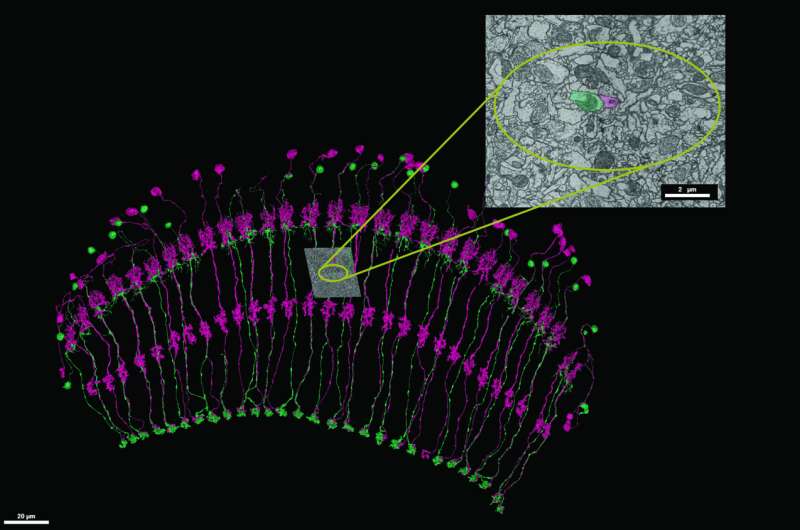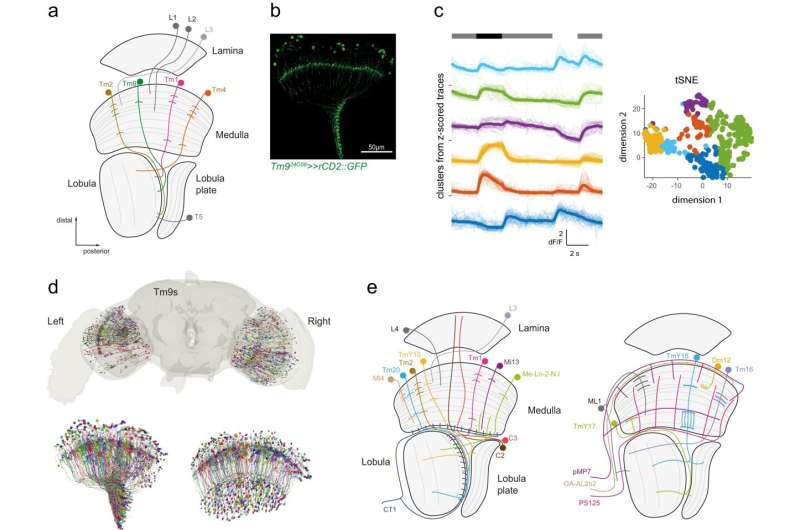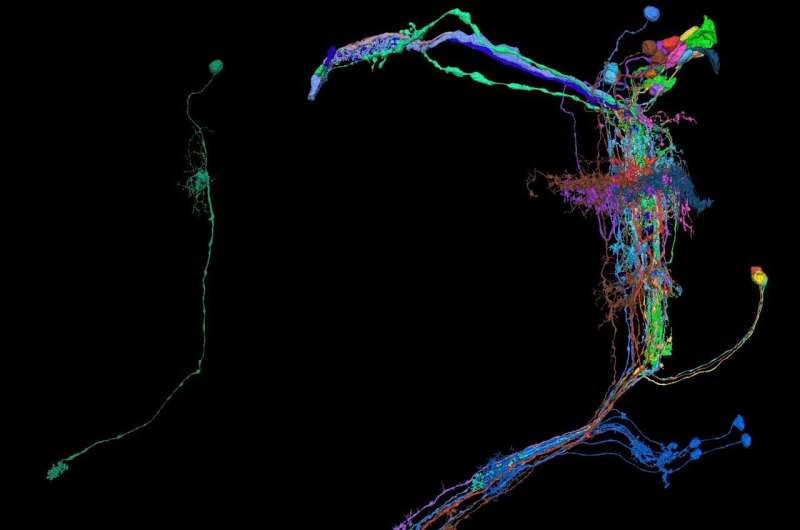This article has been reviewed according to Science X's editorial process and policies. Editors have highlighted the following attributes while ensuring the content's credibility:
fact-checked
peer-reviewed publication
trusted source
proofread
Neurons in the visual system of flies exhibit surprisingly heterogeneous wiring, connectome analysis finds

The brain is a particularly complex organ, not only in humans. Even the brain of a fly contains more than 100,000 neurons connected by millions of synapses. For the first time, an international community of researchers has reconstructed and published all neurons with their corresponding synaptic connections in the brain of an adult female fruit fly, Drosophila melanogaster.
The team of Professor Marion Silies at Johannes Gutenberg University Mainz (JGU) made an important contribution to this research by analyzing neurons of the optic lobes, i.e., those parts of the brain that process visual information. To their surprise, the researchers discovered that a specific type of neuron in the eye of the fruit fly is not homogeneously wired.
"This challenges our current understanding of how the eye is organized," said neurobiologist Silies in view of the findings.
The work is published in the journal Nature Communications.
FlyWire Consortium builds the first whole brain connectome for Drosophila
Spearheaded by a team of researchers at Princeton University and with the help of artificial intelligence, the FlyWire Consortium has been able to map the entire connectome of the brain of Drosophila melanogaster. The term 'connectome' is used to designate all neuron and the synaptic connections between them, which play a significant role for neuronal function.
Hundreds of researchers from across the world supplied the corresponding information. The result is a neural wiring diagram of more than 130,000 nerve cells and 50 million synapses produced by first preparing electron microscope images of ultra-thin sections of brain tissue, then combining the images, tracing neurons, and annotating cell type identities.

"This data set is unique and will revolutionize the entire field of neurobiology," said Professor Silies. "Thanks to this information, we can now far better analyze how the brain works."
Silies' team at the Institute of Developmental Biology and Neurobiology (IDN) at Mainz University is specialized in visual system research and has thus contributed to the successful outcome of the FlyWire project while also uncovering new aspects of how visual information is processed.
At the core of their discovery are certain transmedulla cell types that are located just two synapses behind the photoreceptors in the roughly 800 individual units of the compound eye of the fruit fly. "Visual systems have a homogeneous structure, which was thought to extend also to the level of synaptic wiring," explained Silies. The principle of homogeneous wiring of the eye was thought to apply to Drosophila melanogaster as well as to humans.
After all, it would make sense because the environment should be perceived and processed in the same way in different regions of the eye.
Neurons are not as homogeneously wired as was thought
"We have determined now that certain neurons, for example of the transmedulla cell type Tm9, have heterogeneous connectivity rather than homogeneously wiring," said the team. Previous observations have shown that these cells do not always react identically to a specific stimulus. Silies' team has now proposed a possible explanation for this phenomenon.

"It appears that the fly's eye processes visual inputs differently at different points in space," the author explained. To verify that their findings in the case of the Tm9 cells were not an unusual feature present in a single female fruit fly, the group produced additional light microscopy images of samples from other fruit flies, providing corroborating evidence.
"The next step is to find out whether there is a specific pattern underlying this variability or whether it is just a random occurrence," said Professor Marion Silies, outlining future research.
For Silies, this work raises the question of why there is this heterogeneity in the fly's visual system. Is it some kind of chance side effect or is the variability necessary for robust visual processing?
Her group will continue to explore this fundamental question with the help of the RobustCircuit Research Unit, which includes other researchers from Mainz University as well as colleagues at Freie Universität Berlin, Humboldt-Universität zu Berlin, and the Zuse Institute Berlin (ZIB).
More information: Jacqueline Cornean et al, Heterogeneity of synaptic connectivity in the fly visual system, Nature Communications (2024). DOI: 10.1038/s41467-024-45971-z
Journal information: Nature Communications
Provided by Johannes Gutenberg University Mainz



















